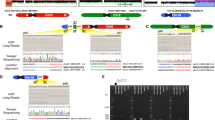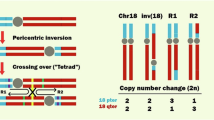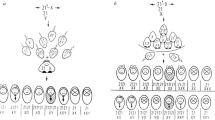Abstract
We have used eight PCR-based DNA polymorphisms to determine the parental origin and mechanisms of formation in 9 patients with de novo nonmosaic tetrasomy 18p. The 9 patients, 4 girls and 5 boys, had clinical features characteristic of i(18p) syndrome. The supernumerary marker chromosome was identified by fluorescence in situ hybridization (FISH) analysis using centromeric probes and a flow-sorted 18p-specific library. The isochromosome was of maternal origin in all 9 cases. The formation of tetrasomy 18p cannot be explained by a single model. In 6 cases, meiosis II nondisjunction, followed by subsequent postzygotic misdivsion, and in 1 case postzygotic nondisjunction and postzygotic misdivision were the most likely mechanisms of formation. Alternative mechanisms are suggested in the remaining 2 cases.
Similar content being viewed by others
Log in or create a free account to read this content
Gain free access to this article, as well as selected content from this journal and more on nature.com
or
References
Frøland A, Holst G, Terslev E: Multiple anomalies associated with an extra small autosome. Cytogenetics 1963;2:99–106
Back E, Toder R, Voiculescu I, Wildberg A, Schempp W: De novo isochromosome 18p in two patients: Cytogenetic diagnosis and confirmation by chromosome painting. Clin Genet 1994;45:301–304
Schinzel A: *trip(18p)* = additional isochromosome 18p: in Schinzel A (ed): Catalogue of Unbalanced Chromosome Aberrations in Man. Berlin, Walter de Gruyter, 1984, pp 620–622.
Callen DF, Freemantie CJ, Rigenbergs ML, Baker E, Eyre HJ, Romain D, Haan EA: The isochromosome 18p syndrome: Confirmation of cytogenetic diagnosis in nine cases by in situ hybridization. Am J Hum Genet 1990;47:493–498
Blennow E, Nielsen KB: Molecular identification of a small supernumerary marker chromosome by in situ hybridization: Diagnosis of an isochromosome 18p with probe L1.84. Clin Genet 1991;39:429–433
Blennow E, Nielsen KB, Telenius H, Carter NP, Kristoffersson U, Holmberg E, Gillberg C, Nordenskjöld M: Fifty probands with extra structurally abnormal chromosomes characterized by fluorescence in situ hybridization. Am J Med Genet 1995;55:85–94
Nielsen KB, Dyggve H, Friedrich U, Hobolth N, Lyngbye T, Mikkelsen M: Small metacentric nonsatellited extra chromosome. Hum Genet 1978;44:59–69
Côté GB, Petmezaki S, Bastakis N: A gene for hypospadias in a child with presumed tetrasomy 18p. Am J Med Genet 1979;4:141–146
Blennow E, Telenius H, Larsson C, de Vos D, Bajalica S, Ponder BAJ, Nordenskjöld M: Complete characterization of a large marker chromosome by reverse and forward painting. Hum Genet 1992;90:371–374
Grimberg J, Nawoschik S, Belluscio L, McKee R, Turck A, Eisenberg A: A simple and efficient nonorganic procedure for the isolation of genomic DNA from blood. Nucleic Acids Res 1989;17:8390.
Saiki RK, Scharf S, Faloona F, Mullis KB, Horn GT, Erlich HA, Arnheim N: Enzymatic amplification of β-globin genomic sequences and restriction site analysis for diagnosis of sickle cell anemia. Science 1985;230:1350–1354
Petersen MB, Frantzen M, Antonarakis SE, Warren AC, Van Broeckhoven C, Chakravarti A, Cox TK: Comparative study of microsatellite and cytogenetic markers for detecting the origin of the nondisjoined chromosome 21 in Down syndrome. Am J Hum Genet 1992;51:516–525
Straub RE, Speer MC, Luo Y, Rojas K, Overhauser J, Ott J, Gilliam C: A microsatellite genetic linkage map of human chromosome 18. Genomics 1993;15:48–56
Gyapay G, Monssette J, Vignal A, Dib C, Fizames C, Millasseau P, Marc S: The 1993–94 Généthon human genetic linkage map. Nat Genet 1994;7:246–339
Petersen MB, Schinzel AA, Binkert F, Tranebjaerg L, Mikkelsen M, Collins FA, Economou EP: Use of short sequence repeat DNA polymorphisms after PCR amplification to detect the parental origin of the additional chromosome 21 in Down syndrome. Am J Hum Genet 1991;48:65–71
Fisher JM, Harvey JF, Morton NE, Jacobs PA: Trisomy 18: Studies of the parent and cell division of origin and the effect of aberrant recombination on nondisjunction. Am J Hum Genet 1995;56:669–675
Vig BK: Sequence of centromere separation another mechanism for the origin of nondisjunction. Hum Genet 1984;66:239–243
Rivera H, Rivas F, Cantú JM: On the origin of extra isochromosomes. Clin Genet 1986;29:540–541
Van Dyke DL, Babu VR, Weiss L: Parental age, and how extra isochromosomes (secondary trisomy) arise. Clin Genet 1987;32:75–80
Bugge M, Petersen MB, Brandt CA, Hertz JM, Mikkelsen M: DNA studies in trisomy 18. Report of the Second International Workshop on Human Chromosome 18 Mapping 1993. Cytogenet Cell Genet 1994;65:141–165
Acknowledgements
We wish to thank photographer Jette Bune Rasmussen for the layout of the figures. This study was supported by the Danish Biotechnology Research and Development Programme 1991–1995, grant 16/92 from Fonden til Laegevidenskabens Fremme, Kong Christian den Tiendes Fond, Direktoer Jacob Madsens og Hustru Olga Madsens Fond, and Broedrene Hartmanns Fond.
Author information
Authors and Affiliations
Rights and permissions
About this article
Cite this article
Bugge, M., Blennow, E., Friedrich, U. et al. Tetrasomy 18p de novo: Parental Origin and Different Mechanisms of Formation. Eur J Hum Genet 4, 160–167 (1996). https://doi.org/10.1159/000472190
Received:
Revised:
Accepted:
Issue date:
DOI: https://doi.org/10.1159/000472190
Key Words
This article is cited by
-
Prenatal genetic diagnosis of tetrasomy 18p from maternal trisomy 18p: a case report
Molecular Cytogenetics (2022)
-
Pallister-Killian syndrome: clinical, cytogenetic and molecular findings in 15 cases
Molecular Cytogenetics (2018)
-
Adults with Chromosome 18 Abnormalities
Journal of Genetic Counseling (2015)
-
Tetrasomie 18p
Monatsschrift Kinderheilkunde (2008)
-
De novo isochromosome 18p in a female dysmorphic child
Journal of Applied Genetics (2006)



